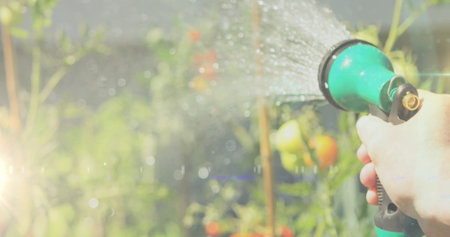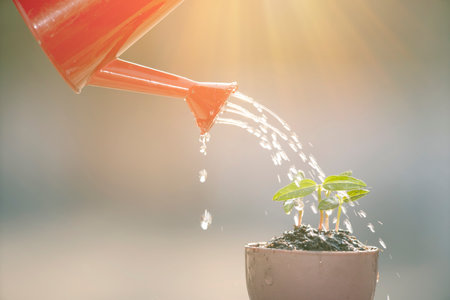Introduction to Smart Watering for Indian Urban Gardens
India’s rapidly growing cities are facing a serious challenge: water scarcity. With increasing urbanisation, limited water resources, and unpredictable monsoon patterns, gardeners in metros like Mumbai, Delhi, Bengaluru, and Chennai find it increasingly difficult to maintain lush home gardens or thriving community spaces. Traditional watering methods often lead to wastage and do not address the specific needs of plants grown in pots, balconies, or small plots typical in Indian cities. Hence, there is an urgent need to adopt smart watering solutions that are both efficient and sustainable. Embracing these techniques ensures that precious water is used wisely, while still nurturing green spaces that contribute to a healthier urban environment. By understanding the unique challenges faced by Indian urban gardeners, we can explore innovative approaches that harmonise with local conditions and cultural practices.
Understanding Indian Climate and Water Needs
India is a land of remarkable climatic diversity, ranging from the humid coasts of Kerala to the arid deserts of Rajasthan and the temperate hills of Himachal Pradesh. Each region has its own unique water requirements and challenges, especially in urban settings where space and resources are limited. To develop smart watering solutions for urban gardens, it is essential to understand both the traditional watering practices rooted in Indian culture and how these can be adapted for modern city living.
Diversity of Indian Climates
| Region | Climate Type | Common Challenges | Traditional Watering Practices |
|---|---|---|---|
| North India (Delhi, Punjab) | Extreme summers & winters, monsoon rainfall | Water scarcity in summers; sudden heavy rains in monsoon | Pots with drainage holes, early morning/evening watering |
| South India (Kerala, Tamil Nadu) | Tropical, high humidity, consistent rainfall | Excess moisture, fungal issues | Coconut husk mulch, rainwater harvesting |
| West India (Maharashtra, Gujarat) | Semi-arid to coastal | Drought-prone periods; saline water in some cities | Drip irrigation with earthen pots (matka), mulching with local materials |
| East India (West Bengal, Assam) | High rainfall, humid subtropical | Waterlogging during monsoons; leaching of nutrients | Bamboo drip irrigation, raised beds for drainage |
| Central India (Madhya Pradesh) | Tropical wet and dry climate | Irregular rainfall; hot summers | Mulching with straw/leaf litter, traditional bunds around plots |
Linking Tradition with Modern Urban Gardening Needs
The wisdom from traditional Indian watering methods offers sustainable ways to manage water efficiently. However, urban gardening introduces new constraints such as limited space, container-based growing, and variable water access. Integrating time-tested practices like early morning watering or using locally available mulches with modern solutions—such as automated drip systems or moisture sensors—can help conserve water while ensuring plants thrive in balcony gardens or rooftop farms.
The Role of Smart Watering Solutions in Indian Cities
Smart watering systems need to be adaptable to the regional climate and compatible with locally grown crops—whether you’re nurturing tulsi on a Bengaluru balcony or growing chillies on a Mumbai terrace. A thoughtful blend of tradition and technology not only supports sustainability but also honours Indias deep-rooted relationship with nature and mindful cultivation.

3. Innovative Smart Watering Technologies
Urban gardens across India are embracing a new wave of water-saving solutions designed to address the unique challenges of Indian climates and lifestyles. One of the most effective methods is drip irrigation, which delivers water directly to the roots of plants, minimising wastage and ensuring every drop counts. This technology is especially beneficial for Indian households with limited space, as it can be easily installed on balconies, terraces, or small community gardens.
Another popular solution gaining traction in Indian cities is the use of automated timers. These devices allow gardeners to schedule watering based on optimal times, such as early mornings or late evenings, reducing evaporation and conserving precious water resources. Automated systems can be integrated with soil moisture sensors, ensuring that plants receive just the right amount of water, which is crucial during hot Indian summers.
In addition to these modern technologies, traditional practices like rainwater harvesting are being revitalised in urban settings. Apartment communities and gated societies are increasingly adopting rooftop rainwater collection systems. By storing monsoon rains, residents can supplement their garden’s water needs throughout the year, reducing dependence on municipal supplies and honouring age-old Indian wisdom of living in harmony with nature.
Together, these innovative approaches reflect a blend of modern science and time-tested traditions, supporting urban gardeners in India to grow healthy plants while nurturing Jal Shakti (water power) for a sustainable future.
Integrating Sustainability and Traditional Wisdom
Urban gardeners in India can create thriving, resilient gardens by blending ancient Indian water-saving techniques with modern smart watering systems. This fusion not only supports environmental sustainability but also honours India’s rich agricultural heritage. For generations, Indian farmers have relied on resourceful methods like mulching with organic waste—such as dry leaves, coconut husks, and kitchen scraps—to retain soil moisture and suppress weeds naturally. Another time-tested practice is the use of earthen pots (matka), which slowly release water to plant roots, conserving water even during harsh summers. By integrating these traditional approaches with today’s intelligent irrigation technologies, urban gardens can achieve optimal results.
The Power of Combining Old and New
When smart sensors monitor soil moisture and automate watering schedules, they work even better alongside mulch or matka systems. The mulch keeps the soil cool and reduces evaporation, while the matkas provide steady hydration right at the root zone. Smart controllers can further fine-tune watering based on real-time weather data, ensuring that plants never receive too much or too little water.
Comparison of Traditional and Modern Watering Solutions
| Method | Description | Benefits |
|---|---|---|
| Mulching with Organic Waste | Layering natural materials over soil | Reduces evaporation; enriches soil health; low cost |
| Earthen Pot Irrigation (Matka) | Burying clay pots filled with water near plants | Slow, deep watering; minimal waste; eco-friendly |
| Smart Drip Irrigation | Sensors & timers control water flow to roots | Precision watering; saves time & resources; scalable for any garden size |
Sustainable Impact for Indian Urban Gardens
This combination approach empowers city dwellers to grow healthy food or flowers using less water and fewer synthetic inputs. By weaving together traditional wisdom and today’s technology, urban gardeners contribute to India’s sustainable future while enjoying lush, productive green spaces at home.
5. DIY and Affordable Approaches for Indian Gardeners
Smart watering doesn’t always require high-tech gadgets or expensive investments. For urban gardeners across India, from enthusiastic schoolchildren in Mumbai to wise elders in Chennai, there are plenty of practical, low-cost solutions that can be implemented with locally available materials. Here are some accessible ideas to make your urban garden more water-wise:
Use of Clay Pots (Matka Irrigation)
Traditional matkas, or unglazed clay pots, can be buried beside plants and filled with water. The porous material slowly releases moisture directly to the roots, reducing evaporation and saving water. This method is especially effective for balcony gardens and rooftop setups common in Indian cities.
Rainwater Harvesting at Home
Collecting rainwater from rooftops using barrels or large drums provides a free and sustainable source of irrigation. Simple mesh filters keep debris out, and stored rainwater can be distributed using buckets or homemade drip systems, especially during dry spells.
Repurposing Household Items
Old plastic bottles, coconut shells, or even used pipes can be turned into slow-release water dispensers. Poke small holes into bottles, fill them with water, and place them near the plant base for gradual soil moisture—perfect for busy families or elders who may not water daily.
Mulching with Local Materials
Using dried leaves, coconut husk, or straw as mulch helps retain soil moisture and reduces the need for frequent watering. These materials are readily available in local markets and even from neighborhood trees.
Community Collaboration
Forming local gardening groups allows sharing of resources like hoses, watering cans, and harvested rainwater. Schools can involve students in creating shared compost pits and irrigation experiments, fostering a culture of sustainability among the next generation.
Empowering Every Age Group
No matter your age or experience level, these DIY smart watering techniques put efficient irrigation within everyone’s reach. By embracing affordable methods rooted in Indian tradition and resourcefulness, urban gardeners can nurture thriving green spaces while conserving precious water.
6. Case Studies and Success Stories from Indian Cities
Across India’s bustling urban centres, many residents have embraced smart watering solutions to transform their balcony, terrace, and kitchen gardens into thriving green spaces. Here are some inspiring success stories from Mumbai, Bengaluru, and Delhi that highlight the practical benefits of these innovative systems.
Mumbai: Maximising Water Efficiency in High-Rise Living
In Mumbai’s densely populated Bandra neighbourhood, Mrs. Priya Shetty converted her small balcony into a lush kitchen garden using a drip irrigation kit equipped with a soil moisture sensor. By scheduling watering during early mornings and connecting the system to her smartphone, Priya reduced water consumption by almost 40%. Her basil, mint, and chillies flourish even during the city’s dry spells, proving that smart irrigation is not just about saving water but also about ensuring healthy plants year-round.
Bengaluru: Tech-Savvy Terrace Gardens
Bengaluru resident Mr. Arvind Rao uses an automated micro-sprinkler system for his terrace vegetable patch in Indiranagar. Integrated with a weather-based controller, his setup adjusts watering schedules based on local rainfall predictions. During monsoon months, the system pauses automatically to avoid overwatering. Arvind proudly shares surplus tomatoes and greens with neighbours, showcasing how technology empowers urban communities to grow more with less water.
Delhi: Sustainable Practices Amidst Water Scarcity
Faced with frequent water shortages in South Delhi, Ms. Geetika Sharma adopted a rainwater harvesting unit connected to a solar-powered drip irrigation system for her rooftop garden. The collected rainwater sustains her herbs and flowering plants throughout the dry season. Her approach has inspired others in her apartment block to implement similar eco-friendly watering solutions, turning their shared rooftop into an oasis despite challenging conditions.
Key Learnings from Urban Gardeners
These real-life examples underline several important lessons for Indian urban gardeners:
- Smart watering systems can be customised for balconies, terraces, or rooftops of any size.
- Integrating local climate data helps optimise water usage and plant health.
- Community sharing of knowledge encourages widespread adoption of sustainable practices.
Empowering Urban India to Grow Sustainably
The experiences of Mumbai, Bengaluru, and Delhi residents demonstrate that smart watering solutions are not just feasible—they are vital for building greener cities. By combining traditional Indian gardening wisdom with modern technology, urban dwellers can create self-sustaining gardens that conserve resources and foster community well-being.
7. Tips for Sustainable Water Management in Indian Urban Homes
Actionable Tips for Eco-Friendly Water Use
1. Water Early or Late
Water your plants either early in the morning or after sunset to reduce evaporation. This helps maximize water absorption, especially during peak summer months and festival times when water demand is high.
2. Embrace Mulching
Use locally available organic mulches like coconut husk, dried leaves, or sugarcane bagasse to retain soil moisture and suppress weeds. Mulching is particularly effective for Indian native species such as tulsi, curry leaf, or hibiscus.
3. Harvest Rainwater
Install rainwater harvesting systems on rooftops to collect monsoon rains. Stored rainwater can be used for garden irrigation during dry spells and restricted municipal supply days, aligning with local water regulations.
4. Reuse Household Water
Greywater from washing vegetables or rice can be used for watering ornamental plants (avoid using soapy water on edibles). This practice conserves fresh water while embracing the Indian principle of zero waste.
5. Match Plants to Climate
Select drought-tolerant and native plant varieties like marigold, amaranth, and lemongrass that thrive in local conditions with minimal water input. This reduces dependency on frequent watering and fits urban schedules around festivals such as Diwali or Holi.
Sustainable Watering Checklist
- Check local municipal water supply timings and plan watering accordingly to avoid peak usage hours.
- Mulch all containers and beds with natural materials after every major festival clean-up.
- Inspect drip irrigation lines weekly for leaks, especially before festival seasons when guests increase household water consumption.
- Clean rainwater filters at least once every monsoon cycle.
- Rotate watering days among different plant zones to balance demand on limited resources.
Cultivating a Resilient Urban Garden
Sustainable water management in Indian urban homes is not just about saving resources—it’s about honoring local traditions, respecting nature’s cycles, and cultivating abundance through mindful practices. By following these tips and using the checklist, urban gardeners can nurture vibrant gardens that flourish year-round while supporting India’s journey toward sustainable living.


